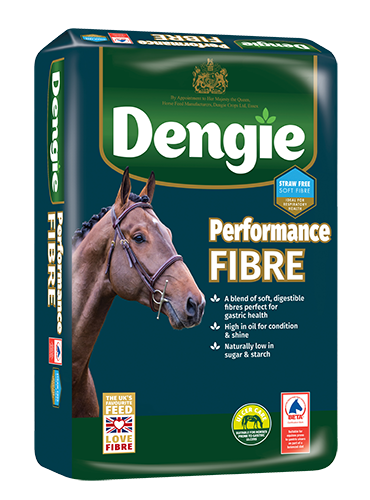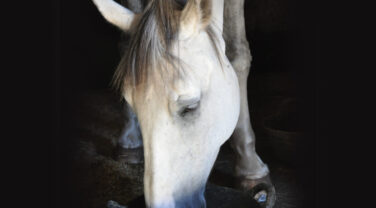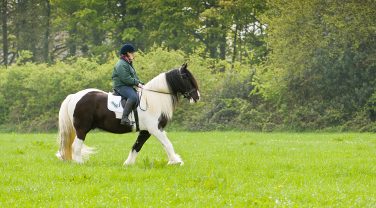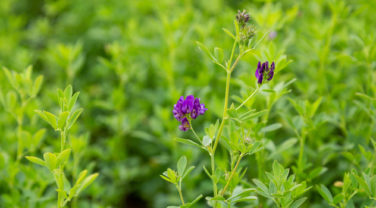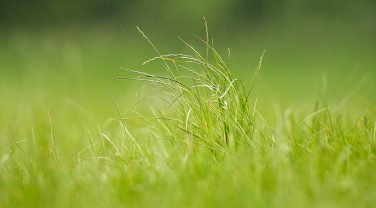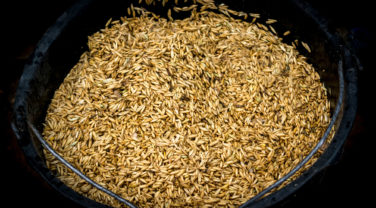
Ulcers in Horses
Over the last decade, research has increased our understanding of Equine Gastric Ulcer Syndrome (EGUS) more commonly referred to as gastric ulcers in horses.
Two distinct diseases have been identified which can affect different areas of the stomach; Equine Squamous Gastric Disease (ESGD), and Equine Glandular Gastric Disease (EGGD). Whilst we know the risk factors for ESGD, less is understood about EGGD.
It can be confusing knowing what to feed a horse with ulcers and so the team of nutritionists at Dengie are available to help you feed advice.
Symptoms of ulcers (EGUS) in horses
The symptoms of ulcers in horses are not easy to distinguish from other issues or diseases, but some common ones include weight loss, dull coat, biting when being girthed, and intermittent colic. Historically, ulcers have been associated with underweight horses and ponies, however, it is important to understand that good doers and overweight horses can have ulcers, too. It is also apparent that there is no link between the severity of ulcers and the symptoms – some horses are clearly very stoic with grade 4 ulcers and no signs of any problems are visible on the outside!
Feeding strategies that increase the risk of gastric ulcers in horses:
- Low fibre diets – chewing high fibre feeds produces more than double the amount of saliva than chewing concentrates and saliva contains bicarbonate which helps to neutralise acidity in the horse’s stomach. Too little fibre in the ration reduces the amount of saliva produced which can result in more acidic stomach contents.
- Feeding 1% of bodyweight of cereal grain resulted in a marked increase in ulcers even in in non-exercised horses. Cereals are broken down to strong acids and so high levels of grain increase acidity levels in the stomach
- Feeding 2g/kg BW starch per day or 1g/kg BW per meal more than doubled the risk of gastric ulcers in horses.
Gastric Ulcer Risk Calculator
There are lots of different factors that increase a horse’s risk of developing gastric ulcers. We have developed a questionnaire to help you ascertain your horse’s risk level.
Feed For Horses With Ulcers
Feeding horses with ulcers is focused on reducing risk factors – follow these top tips to keep your horse in a healthy condition:
- Feed plenty of forage to increase chew time and therefore saliva production, which will naturally regulate the levels of acidity in the stomach. Use low-calorie forages for good doers to provide chew time without weight gain.
- Focus on feeding little and often – dividing the total forage ration into as many small meals as possible helps to keep the time the stomach is empty as short as possible.
- Try to avoid the use of cereal-based concentrates as these increase the risk of ulcers in horses. Use more digestible fibre sources like alfalfa with added oil to meet energy requirements. For example, our Healthy Tummy provides 11.5MJ/kg of slow-release energy which is equivalent to a medium energy mix. Alfa-A Oil and Performance Fibre provide the same energy level as a conditioning or competition mix but with much lower levels of starch. Performance Fibre is ideal if you have a fussy feeder.
- Include alfalfa in the feed for horses with ulcers. Research has shown that alfalfa is a better buffer to acidity than other fibre sources due to its protein and calcium content. The Dengie Alfa-A range is based on pure alfalfa and provides the most buffering potential – they have a range of energy levels so pick the one that meets your horse’s energy requirements.
- Feed a small amount of fibre about 20-25 minutes before exercising so the horse doesn’t have an empty stomach when moving – a handful or two of chopped fibre is ideal and helps to stop the acidic contents of the stomach splashing around when the horse moves
- Exercise intensity may need to be reduced to allow ulcers to heal. For ulcers in the gastric region of the stomach, research has shown that 2 days off a week rather than one is beneficial.
- Turn out as much as possible and try to avoid any unnecessary stressful situations, which could make the symptoms of ulcers in horses much worse.
For horses with EGGD
A consensus statement was published by specialists representing the European College of Equine Internal Medicine (ECEIM) about EGGD. It stated that there is no proven link between diet and EGGD, but it was recommended to implement the same feeding strategies as for squamous gastric ulcers in horses (outlined above). In addition, the following advice was given:
- Provide a minimum of 2 rest days from work per week if possible, or provide regular rest periods.
- Turn-out where possible provided the horse does not become stressed by turnout. Some horses that are not accustomed to turn-out may be less stressed in a stable environment.
- Minimise management changes and other potential stressors.
- Minimise changes in equine companions and human carers.
Starch Calculator
At Dengie, all of our horse feeds are naturally low in starch but we are often asked about starch levels in other feeds and how to work out the amount of starch a horse is consuming each day. To help, we have devised a simple tool that allows you to input the details relating to your horse’s diet. Click here to work out your horse’s current starch intake.
Managing Horses with EGUS
Some preliminary work has indicated that the effect of using omeprazole, the most common medicine for gastric ulcers, is a possible reduction in calcium absorption. This is because the change in acidity levels in the digestive system impacts the absorption of calcium from the gut.
This side-effect of ulcer treatment is seen in humans and is now thought to affect horses too – although only one study has been published to date. Whether or not it is sufficient to contribute to bone demineralisation which increases the risk of fractures in the horse, is yet to be demonstrated, but the recommendation from the researchers carrying out the study would be to increase calcium intake in horses receiving omeprazole.
Alfalfa is a great way to achieve this given the calcium it contains has a high bioavailability compared to other sources such as limestone flour.
If you are looking for further feed advice to help with signs of ulcers in horses, we’re happy to provide assistance. , Please contact us if you have queries relating to any issue including laminitis and colic
Frequently Asked Questions
Should the diet of every horse be low in starch and sugar?
A key concept to consider is that it isn’t just the level of sugar and starch within a feed but also how much of the feed is fed, and how quickly it is consumed that is important. Grass forages and pasture are consumed more slowly than bucket feed, so even though they contain relatively high levels of sugar, it is consumed throughout the day rather than in meals which the horse’s digestive system has evolved to cope with.
Obesity, PPID, and laminitis all change the ability of the horse to cope with sugar intake, and in these situations, 10-12% non-structural carbohydrate (NSC – the combination of sugar and starch) in forage is recommended. A typical value for grass hays is around 15-20% and a very high level would be 35%. As horses should be fed 1.5% minimum of forage per day to supply sufficient fibre to maintain normal gut function it makes a big contribution to the overall NSC intake.
With bucket feed, starch is a significant risk factor for diseases such as colic and gastric ulcers. It is generally advised to keep levels as low as possible to maintain digestive health in all horses. The maximum level of starch advised to try to reduce the risk of gastric ulcers is 1g/Kg bodyweight (BWT) per meal or 2g/Kg BWT per day. It is possible to supply energy from fibre and oil to the same level as cereal-based feeds and the levels of starch can be around 10 times lower i.e., 2% in Alfa-A Oil compared to 20% in competition mixes of the same energy value.
Producers of mixes and cubes may describe their feeds as “low starch” even though they still contain 12-15%. This is because they are comparing them to more traditional versions of the same product that are likely to contain between 25 and 30% starch. This doesn’t mean they are low in starch when compared to other types of feed though.
My horse is an eventer and is working quite hard but has recently been diagnosed with ulcers. My vet has told me to just feed fibre - can I really do that and still compete at a decent level?
Absolutely! Alfa-A Oil is our highest energy feed at 12.5MJ DE per kg which is comparable to a competition or conditioning mix. However, it contains around 10 times less starch than a cereal-based feed with a comparable energy value so is much better for gut health. The fibre and oil provide slow-release energy and so you may find that your horse’s behaviour and focus will improve too. A study we supported a few years ago showed that horses on fibre and oil-based diets were less reactive to novel stimuli than those on a cereal-based ration. Don’t just take our word for it though – 4* eventer Lucy Jackson has competed at the highest level on a fibre-based diet!
My horse has ulcers and doesn’t seem to want to eat much hay. He really doesn’t seem to like chops, what else can I use so he spends more time eating?
If you can turn out on good grazing then that would be a great starting point. In addition, it would be good to get some alfalfa into his ration as it is a natural buffer to acidity. There are some pelleted versions of alfalfa that you can use – pure Alfalfa Pellets can be fed dry or dampened with water if he prefers them that way, or Alfa-Beet which is a combination of unmolassed sugar beet and alfalfa which must be fed soaked before feeding.
Although a horse would tend to consume a pelleted/soaked version of alfalfa more quickly than chopped fibre, and therefore spend less time chewing, the main aim in this situation is to increase fibre intake and find a form of fibre your horse likes. Once the ulcers have healed, you may find your horse’s appetite picks up a bit and you can try introducing some chopped fibre again.
My cob is a really good doer and so is on very limited hay and basically no grazing. She has had ulcers in the past and I know I need to feed as much fibre as possible, but I’m worried about her putting on weight. I’m also concerned about using low-calorie feeds as they contain straw, and I’ve read I shouldn’t feed it as it can cause ulcers?
The minimum amount of forage your horse should ideally be consuming is 1.5% of her bodyweight on a dry matter basis. To try to promote good gut health, the total daily ration should be divided into as many small offerings as possible so the period she isn’t eating is as short as possible. Research by Luthersson and colleagues showed that if the time between eating was more than 6 hours, the risk of ulcers increased.
Straw can be a really useful feed material for good doers as it provides “chew-time” without too many calories. In the study by Luthersson and colleagues, they also found that when straw was the sole source of forage it increased the incidence of ulcers. However, the important part of this finding was that straw was the only type of forage fed. There is no reason why straw can’t be used alongside other forages such as alfalfa and grass hay to increase fibre intake for good doers. Feeds such as Ulser Lite, Hi-Fi Lite or Hi-Fi Molasses Free would therefore be suitable options for your horse.
I have been told to give my horse a small feed before exercise. Is this safe?
Yes – providing it is fibre based. The advice is to give a scoop of chopped fibre within 30 minutes before exercise. This recommendation is given to make sure that the fibrous mat within the horse’s stomach is maintained to reduce acid splashing about in the stomach. Acid splash in the squamous or non-glandular lining of the horse’s stomach is linked to gastric ulceration. Ideally, this chopped fibre should include alfalfa as research has shown that alfalfa particularly is a superior buffer to acidity within the digestive tract.





